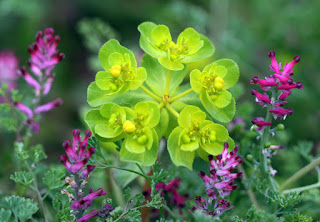 |
| Coltsfoot Image: D. Steere |
On Monday, we brought you the first part of David Steere's story of how, in just four years, he went from not knowing the difference between a Dandelion and a Cotsfoot, to becoming a highly-valued botanical recorder in his home county of Kent.
At the end of part one, we left him having just bought his first wildflower ID book and realising that he "knew very little about plants".
Now find out what David did next:
 |
| Monkey Orchid Image: D. Steere |
"I amassed lots of old wildflower books from charity shops
and wildlife reserve shops and realised my first little book was rather limited
and the colour drawings of wildflowers were often inaccurate or vague.
"As these
books were inspiring but rather useless at field identifications I turned my
research to the internet. Here I found a wealth of information and web sites,
the two most influential to me being www.birdforum.net
which had a wildflower and UK orchid forum and http://www.ukwildflowers.com which
lists most wildflowers found in the UK.
"I also bought a copy of Harrap's Wild Flowers which had fantastic colour photos of most species with a good
description of how to identify it. I followed this up with Wild Flowers of Britain and Ireland by Blamey, Fitter and Fitter which had additional detail,
but importantly, covered many alien species commonly found in the wild.
 |
| Late Spider-orchid photographed on Folkestone Downs Image: D. Steere |
"Being fascinated by the orchids I had already found, I did
lots of online research and resolved to find more Kent orchids, so in 2014 I
set off to several well known sites and in a few short visits I found all the
major species recorded in Kent, including Man, Lady, Greater Butterfly, Early and
Late Spider, Monkey and many more.
"It was an amazing time of discovery and
wonder. I had no idea my own countryside
had such stunning gems within it waiting to be found. In 2015 I set out to find
orchids not in nature reserves and my star find was a population of previously unrecorded Lady
Orchids, possibly never seen before by botanists.
"British and Irish orchids are amazing, yet I couldn't fail
to notice other species along the way, from Eyebrights to Yellow-wort, Poppies
to assorted Toadflax and so my interests considerably broadened.
 |
| Lady Orchid, Luddesdown, Kent Image: D. Steere |
"I started
photographing and logging all wildflowers I could identify. I wanted to find the
wonderful flowers shown in Harrap's book for myself.
"One big tip I learned
early on was that taking some photos of a plant's flowers is often insufficient
to identify the plant in front of you.
"I quickly learned to take detailed
photos of every bit of any plant I couldn't identify, including the underside
of leaves and if possible even the type of hairs on the leaves. I still do that today which is invariably sufficient to gain a firm identification from Twitter
botanists or my County Recorder.
"In 2015 I joined the Kent Botanical Recording Group which is
free to join. I was welcomed from the start and enjoyed attending their field
trips, where in a few hours with local experts I learned more than I could have
done in a year of solo trips. They took time to explain the differences in
species and what to look for.
 |
| Field of Common Poppy, Eynsford, Kent Image: D. Steere |
"In addition to that, they put out a newsletter
and Kent Botany each year with a wealth of information within them. I would
highly recommend you join your local county group (see https://bsbi.org/ and click on your county from the map
shown). Or use the list here.
"Feeling a bit
embarrassed about it, I decided I would try to learn them as well and here's how I managed to remember seemingly impossible names, such as Tripleurospermum
inodorum and Helminthotheca echioides: I became a BSBI member and started recording
for the BSBI Atlas 2020.
 |
| July flowers at Lullingstone, Kent Image: D. Steere |
"To do this I could only record species whose identity I was
100% sure of. I then entered my finds into a spreadsheet, but you have to use
the scientific names to do so.
"As such, after repeatedly typing in common
plants the names stuck in my memory.
"Another tip is to mentally say the scientific name to yourself each time you notice it. Just walking down an urban street, I'm muttering to myself “Stellaria media, Euphorbia peplus, Conyza canadensis” etc. I now find I sometimes struggle to remember a plant's common name!"
 |
| Sun spurge and Dense-flowered fumitory Image: D. Steere |
Let's leave David there, walking down the street muttering scientific names (yes, I do it too and so does every botanist I know!), enjoying being an active BSBI member and expanding his botanical knowledge.
Tune in next week when we bring David's story bang up-to-date with the third and final part of his story: his recent botanical finds, his pet hates and obstacles encountered, how he overcame them and now helps beginner botanists expand their knowledge.
No comments:
Post a Comment
Please leave a comment!